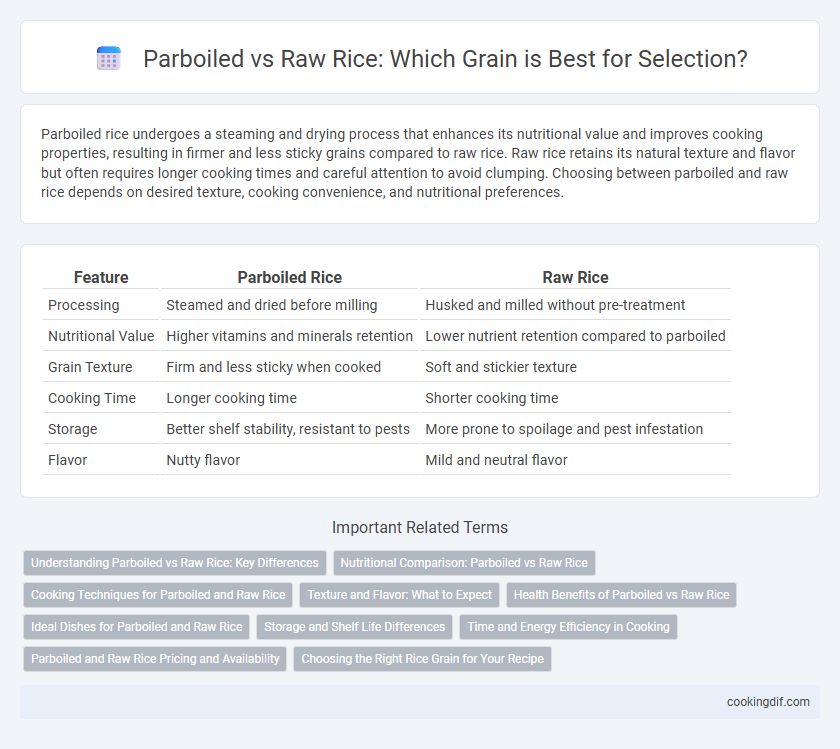Parboiled rice undergoes a steaming and drying process that enhances its nutritional value and improves cooking properties, resulting in firmer and less sticky grains compared to raw rice. Raw rice retains its natural texture and flavor but often requires longer cooking times and careful attention to avoid clumping. Choosing between parboiled and raw rice depends on desired texture, cooking convenience, and nutritional preferences.
Table of Comparison
| Feature | Parboiled Rice | Raw Rice |
|---|---|---|
| Processing | Steamed and dried before milling | Husked and milled without pre-treatment |
| Nutritional Value | Higher vitamins and minerals retention | Lower nutrient retention compared to parboiled |
| Grain Texture | Firm and less sticky when cooked | Soft and stickier texture |
| Cooking Time | Longer cooking time | Shorter cooking time |
| Storage | Better shelf stability, resistant to pests | More prone to spoilage and pest infestation |
| Flavor | Nutty flavor | Mild and neutral flavor |
Understanding Parboiled vs Raw Rice: Key Differences
Parboiled rice undergoes a steaming and drying process before milling, which enhances its nutritional profile by driving vitamins and minerals from the bran into the grain, resulting in a firmer texture and longer shelf life compared to raw rice. Raw rice retains its natural texture and flavor but has a shorter cooking time and softer consistency, making it ideal for dishes requiring fluffier grains. Choosing between parboiled and raw rice depends on desired nutritional benefits, cooking methods, and preferred taste and texture in culinary applications.
Nutritional Comparison: Parboiled vs Raw Rice
Parboiled rice retains more nutrients than raw rice due to the soaking and steaming process, which drives vitamins and minerals from the bran into the grain. This method significantly increases the content of B vitamins, such as thiamine and niacin, as well as enhances iron and calcium levels. Raw rice, lacking this treatment, generally has lower nutrient density and higher cooking times.
Cooking Techniques for Parboiled and Raw Rice
Parboiled rice requires a longer cooking time and benefits from soaking beforehand to ensure even water absorption, producing grains that are firmer and less sticky compared to raw rice. Raw rice cooks faster and typically uses the absorption or boiling method, resulting in a softer texture ideal for dishes requiring fluffier grains. Different cooking techniques highlight the unique texture and nutritional retention properties of parboiled versus raw rice varieties.
Texture and Flavor: What to Expect
Parboiled rice offers a firmer, less sticky texture due to the steaming process that enhances grain hardness, making it ideal for dishes requiring separate, fluffy grains. Raw rice typically yields a softer, stickier texture with a milder flavor, blending well in recipes like risottos or sticky rice desserts. Flavor differences are notable; parboiled rice has a nuttier, earthier taste, while raw rice maintains a neutral flavor adaptable to diverse seasoning profiles.
Health Benefits of Parboiled vs Raw Rice
Parboiled rice retains more nutrients such as vitamin B6, niacin, and magnesium due to the steaming process that drives nutrients from the bran into the grain, enhancing its health profile compared to raw rice. It has a lower glycemic index, which helps in better blood sugar management and supports weight control. The increased resistant starch in parboiled rice also aids digestive health by promoting beneficial gut bacteria growth.
Ideal Dishes for Parboiled and Raw Rice
Parboiled rice retains more nutrients and has a firmer texture, making it ideal for dishes like biryanis, pilafs, and fried rice where separate, fluffy grains are preferred. Raw rice absorbs flavors well and cooks faster, suitable for risottos, sushi, and steamed rice dishes that require a softer, stickier consistency. Choosing between parboiled and raw rice depends on the desired texture and cooking method to complement the specific cuisine.
Storage and Shelf Life Differences
Parboiled rice has a longer shelf life and better storage stability compared to raw rice due to its partially cooked process, which reduces microbial contamination and enzymatic activity. Raw rice is more susceptible to insect infestation, moisture absorption, and spoilage, requiring more controlled storage conditions to maintain quality. Proper airtight packaging and stable, low humidity environments are crucial for extending the shelf life of both rice types, but parboiled rice offers greater resilience under varied storage conditions.
Time and Energy Efficiency in Cooking
Parboiled rice requires less cooking time and conserves energy due to its pre-steaming process that partially gelatinizes the starch, leading to faster water absorption. Raw rice demands longer boiling periods, increasing fuel consumption and overall energy expenditure during meal preparation. Selecting parboiled rice enhances time efficiency and reduces energy costs, making it ideal for households prioritizing quick and sustainable cooking methods.
Parboiled and Raw Rice Pricing and Availability
Parboiled rice typically commands a higher price than raw rice due to its labor-intensive processing, which enhances shelf life and nutritional content. Availability of parboiled rice fluctuates based on regional demand, with higher supply in South Asian and African markets, whereas raw rice remains more universally accessible worldwide. Market trends indicate raw rice offers a more cost-effective option for bulk buyers and food manufacturers.
Choosing the Right Rice Grain for Your Recipe
Parboiled rice retains more nutrients and has a firmer texture, making it ideal for dishes requiring distinct grain separation, such as pilafs and biryanis. Raw rice offers a softer texture and shorter cooking time, suitable for risottos and sushi where creaminess or stickiness is desired. Selecting between parboiled and raw rice depends on the recipe's texture and cooking requirements to achieve optimal flavor and consistency.
Parboiled vs Raw for rice grain selection Infographic

 cookingdif.com
cookingdif.com